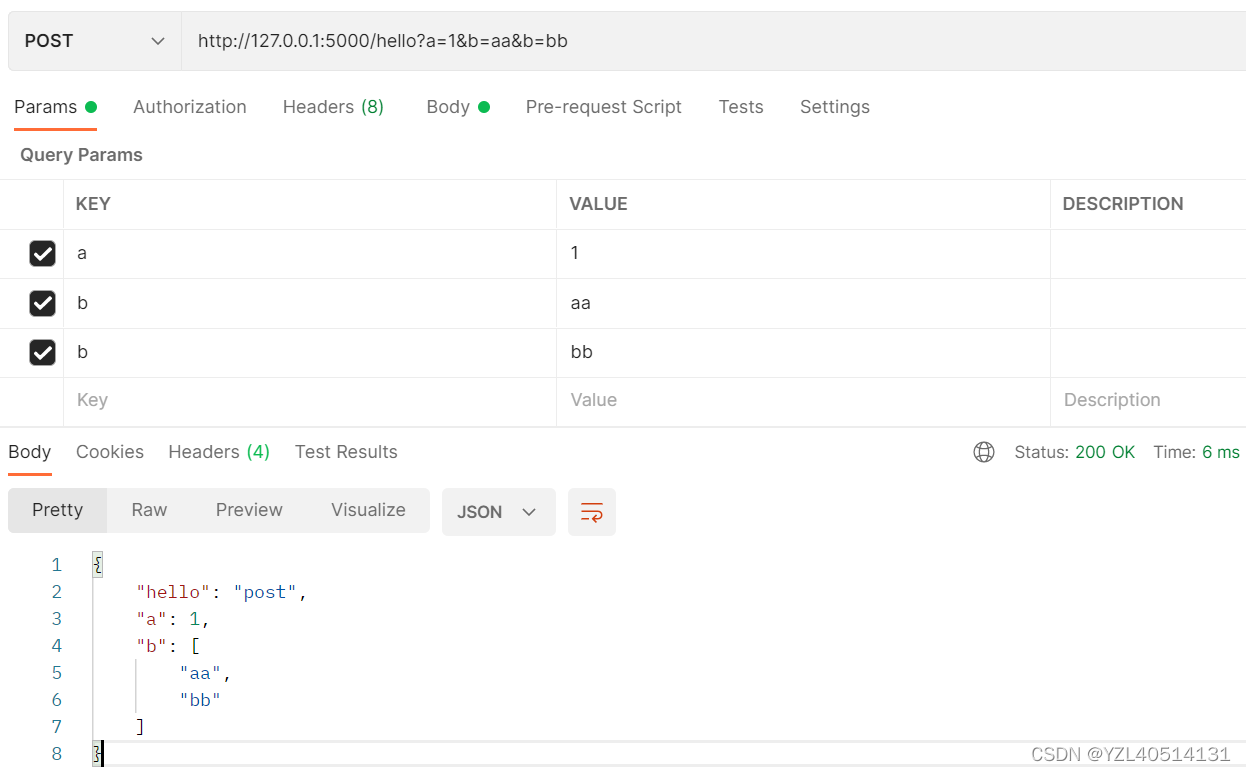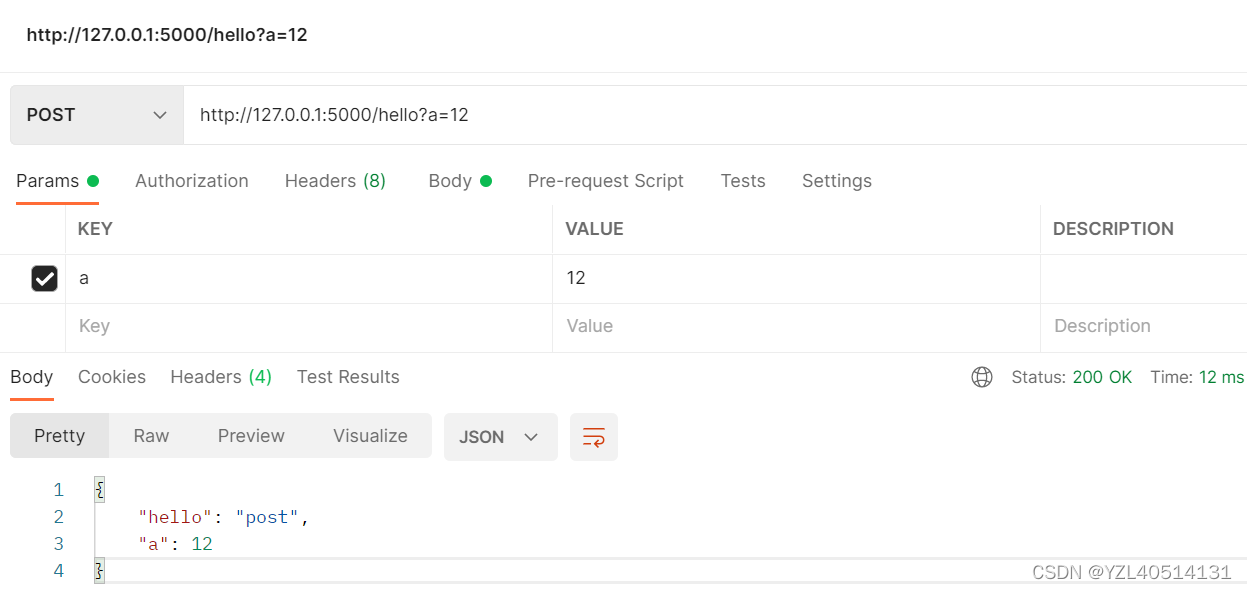1、RequestParser类
Flask-RESTful 提供了RequestParser类,用来帮助我们检验和转换请求数据。
使用步骤:
1.创建RequestParser对象
2. 向RequestParser对象中添加需要检验或转换的参数声明
3. 使用parse_args()方法启动检验处理
4. 检验之后从检验结果中获取参数时可按照字典操作或对象属性操作
代码块:
2、参数说明
1、required:描述请求是否一定要携带对应参数,默认值为False
- True 强制要求携带;若未携带,则校验失败,向客户端返回错误信息,状态码400
rq.add_argument('a',type=int,required=True,help='参数a错误') - False 不强制要求携带;若不强制携带,在客户端请求未携带参数时,取出值为None
rq.add_argument('a',help='参数a错误')
2、help:参数检验错误时返回的错误描述信息rq.add_argument('a',type=int,required=True,help='参数a错误')
3、action:描述对于请求参数中出现多个同名参数时的处理方式
- action=‘store’ 保留出现的第一个, 默认
- action=‘append’ 以列表追加保存所有同名参数的值
rq.add_argument('b',type=str,required=True,help='参数b错误',action='append')
4、choices:只能选择列表中特定的值rq.add_argument('c',choices=['男','女'])
5、type:描述参数应该匹配的类型,可以使用python的标准数据类型string、int,也可使用Flask-RESTful提供的检验方法,还可以自己定义
- 标准类型
rp.add_argument('a', type=int, required=True, help='missing a param', action='append')
-
Flask-RESTful提供
检验类型方法在flask_restful.inputs模块中- url
- regex(指定正则表达式)
- natural 自然数0、1、2、3…
- positive 正整数 1、2、3…
- int_range(low ,high) 整数范围
rq.add_argument('d',type=_range(1,10))- boolean
-
自定义
def mobile(mobile_str):
if re.match(r'^1[3-9]\d{9}$', mobile_str):
return mobile_str
else:
raise ValueError('{} is not a valid mobile'.format(mobile_str))
rq.add_argument('e', type=mobile)

6、location:描述参数应该在请求数据中出现的位置rq.add_argument('f',type=inputs.boolean,location='form')
from flask import Flask,Blueprint,request
from flask_restful import Resource,Api,reqparse,inputs
app=Flask(__name__)
#步骤1:创建restful的API
api=Api(app)
#步骤二:定义资源resource
class HelloResource(Resource):
def post(self):
#1、 创建RequestParser对象
rq=reqparse.RequestParser()
#2、向RequestParser对象中添加需要检验或转换的参数声明
# required=True:表示参数a必须要传;type=int:表示参数必须是整形
rq.add_argument('a',type=int,required=True,help='参数a错误') #如果定义help,那么所有的校验都是同一个错误提示
#3、使用parse_args()方法启动检验处理
req=rq.parse_args()
#4、校验完成之后获得参数的结果,可按照字典操作或对象属性操作
a=req.a
return {'hello': 'post','a':a}
#步骤3:将资源添加到api中,才可以发布
api.add_resource(HelloResource,'/hello')
if __name__ == '__main__':
app.run(debug=True)

上述测试代码块
from flask import Flask,Blueprint,request
from flask_restful import Resource,Api,reqparse,inputs
import re
app=Flask(__name__)
#步骤1:创建restful的API
api=Api(app)
#步骤二:定义资源resource
class HelloResource(Resource):
def get(self):
return {'hello': 'get'}
def put(self):
return {'hello': 'put'}
def post(self):
#1、 创建RequestParser对象
rq=reqparse.RequestParser()
#2、向RequestParser对象中添加需要检验或转换的参数声明
# required=True:表示参数a必须要传;type=int:表示参数必须是整形
rq.add_argument('a',type=int,required=True,help='参数a错误') #如果定义help,那么所有的校验都是同一个错误提示
#rq.add_argument('a',help='参数a错误') #如果定义help,那么所有的校验都是同一个错误提示
rq.add_argument('b',type=str,required=True,help='参数b错误',action='append')
rq.add_argument('c',choices=['男','女'])
rq.add_argument('d',type=inputs.int_range(1,10))
def mobile(mobile_str):
if re.match(r'^1[3-9]\d{9}$', mobile_str):
return mobile_str
else:
raise ValueError('{} is not a valid mobile'.format(mobile_str))
rq.add_argument('e', type=mobile)
rq.add_argument('f',type=inputs.boolean,location='form')
rq.add_argument('g',type=inputs.boolean,location='args')
rq.add_argument('h',type=inputs.boolean,location='headers')
rq.add_argument('i',type=inputs.boolean,location='cookies')
rq.add_argument('j',type=inputs.boolean,location='json')
rq.add_argument('k',type=inputs.boolean,location='files')
#3、使用parse_args()方法启动检验处理
req=rq.parse_args()
#4、校验完成之后获得参数的结果,可按照字典操作或对象属性操作
a=req.a
b=req.b
c=req.c
d=req.d
e=req.e
f=req.f
g=req.g
h=req.h
i=req.i
j=req.j
k=req.k
return {'hello': 'post','a':a,'b':b,'c':c,'d':d,'e':e,'f':f,'g':g,'h':h,'i':i,'j':j,'k':k}
#步骤3:将资源添加到api中,才可以发布
api.add_resource(HelloResource,'/hello')
if __name__ == '__main__':
app.run(debug=True)

